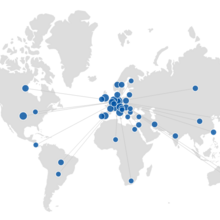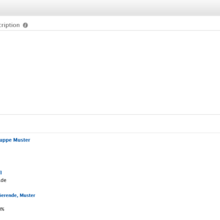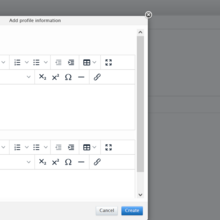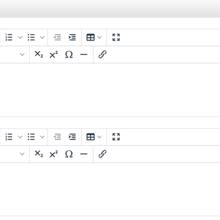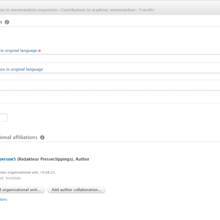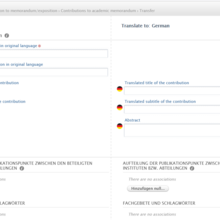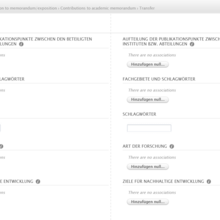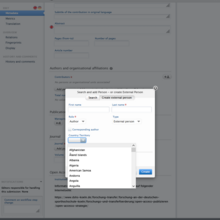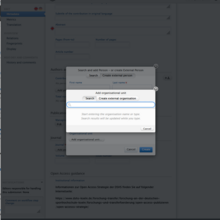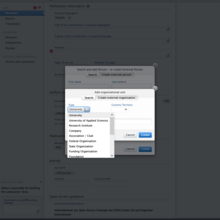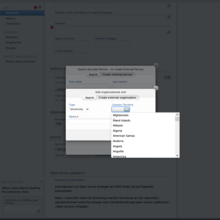CRIS-Helpdesk (Database and Research portal)
General introduction to the CRIS for DSHS Researchers and Research units
The DSHS Current Research Information System (CRIS) consists of the database Pure and the public Pure Portal. The database is exclusively accessible for DSHS users. The Pure Portal is the research portal of the DSHS which is open to the public. The researchers and research units of the DSHS can determine which research information is made available to the public in the portal by means of the settings in the database – for example, in their personal account or in the database entries for which they are responsible.
The CRIS database of the DSHS is connected to the Pure Portal. The CRIS portal offers DSHS researchers and research institutions a whole range of diverse functions. On the homepage, in addition to “Publications”, “Projects” and “Activities”, the data types “Prizes” and “Press/Media” can now be found as independent categories. In addition, “Research data”, “Research infrastructure” and “Research Impacts” are added as new data types.
Furthermore, several features allow for a better presentation of the research profiles of the DSHS and its researchers and research institutions:
- Your research networks can be visualised by world maps and diagrams, highlighting the international interconnectedness of your research.
- The tool of the so-called “Fingerprints” enables you to classify your research in more detail in terms of content via the automatic generation of research fields and keywords.
- With the help of the so-called “SDG buttons” you can link your research directly to the United Nations Sustainable Development Goals for more global justice as well as environmental and climate protection.
- Thanks to the tools PlumX and Altmetric, metric data of your research and interactions in social media become transparent.
General information
Legal bases
According to the „Verordnung über den Betrieb von Forschungsinformationssystemen“ (Regulation on the operation of Current Research Information Systems) of the federal state of North Rhine-Westphalia (NRW) dated 19.08.2020, current research information systems serve the universities and institutions of higher education to fulfil their reporting, information and documentation obligations as well as their quality assurance tasks according to § 8, para. 3 of the „Hochschulzukunftsgesetz“ (HZG NRW), which means the Higher Education Act of NRW dated 16.09.2014. According to the HZG NRW, § 70, para. 4, all the members of the universities are obliged to cooperate in the preparation of these reports.
- Link to the Regulation on the operation of Current Research Information Systems.
- Link to the Higher Education Act of NRW.
DSHS service agreement
According to the service agreement „Nutzung des Forschungsinformationssystems (FIS) PURE“ (FIS DV; Use of the current research information system PURE) between the DSHS scientific staff council and the university represented by the rector, DSHS scientific employees are generally free to use the DSHS CRIS, with the exception of entering publication data into it. According to the FIS DV, this is an official duty of the scientific employees of the DSHS. In addition, the university expects the scientific sections to participate in the research reporting in an appropriate form and to provide information about their research achievements on their own initiative.
- PDF-file of the FIS DV in the DSHS Intranet.
Pure manual
For further information on the use of the DSHS CRIS, we would like to refer you to the Pure manual from Elsevier, the operator of the CRIS database and CRIS portal. You can find it on the starting page of the database Pure at the bottom right under “Help and support” or under this link.
Bilingualism and preference of English
We would like to draw your attention urgently to how important it is for the DSHS CRIS and the external presentation of the university’s research achievements that you make all your research information available in the CRIS database not only in German, but also primarily in English.
This is central to the optimal use of the features of the new CRIS portal. For the automatic generation of research fields and keywords in the form of the “Fingerprints” or for the linking of research achievements with the SDGs of the United Nations, the database and the portal rely exclusively on the English-language text resources in the CRIS database.
- In the case of the CRIS database entries of your person or your Research unit, these include all text resources under “Curriculum and research description” and there the so-called “Profile information” (Researchers), or all your text resources under “Research profile” (Research units).
- In the case of the CRIS database entries of your Publications, Projects, Prizes, Activities, Research data, Press/Media, Research infrastructure, these are the title, the abstract or description and the keywords.
So, make sure that you provide all this research information in German and English.
To do this, use the input fields marked with a German flag in the metadata of your person’s or research unit’s CRIS database entry for the German version of the CRIS portal and, analogously, the input fields marked with a British flag for the English version of the CRIS portal. Please do not enter any German-language information in the fields marked with a British flag and vice versa. This information will otherwise end up in the wrong version of the CRIS portal. To make your research information available in both languages, also use the “Translation” tab in the respective CRIS database entry.
Screenshots for illustration:
Affiliations of external Researchers
The specification of external Research units
In the case of scientific collaboration with external Researchers from other German or international universities, we would like to draw your attention in particular to the importance of always indicating your external partners’ affiliations/ their external Research units in all CRIS database entries.
This is central to the optimal use of the features of the new CRIS portal. For the automatic generation of the network world map and the network diagrams in the CRIS portal to visualise the national and international networking of your research, the database and portal rely on the information of the external affiliations of external Researchers and partners. This applies in particular to the data types “Publications” and “Projects”, but also to all the other data types.
Therefore, make sure that all external Researchers respectively your scientific partners are provided with the correct external affiliations in all CRIS database entries.
Enter the correct external affiliations in the case of “Publications” under “Authors and organisational affiliations” or in the case of all other data types under “Persons and organisational affiliations”. In addition to the external affiliation, also indicate the country to which it belongs.
When specifying external affiliations, be sure to use the correct spelling. Use national and international ID databases that provide persistent identifiers for Research units:
- ROR (Research Organisation Registry), Link.
- ISNI (International Standard Name Identifier) (ISO 22729:2012) Link.
- GERiT (German Research Institutions) Link.
- Wikidata Link.
Screenshots for illustration:
